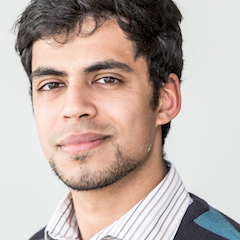Research Assistant
| aaron.pereira@tum.de | |
| Room | MI 03.07.035 |
| Phone | +49.89.289.18144 |
| Fax | +49.89.289.18107 |
| Address | Institut für Informatik VI Technische Universität München Boltzmannstraße 3 85748 Garching bei München Germany |
| Homepage | http://www6.in.tum.de/Main/Pereira http://smart-e-mariecurie.eu/user/30 |

- NEW: Video of current work: Safe Human-Robot Co-Existence
Curriculum Vitæ
I completed my Masters in Mechanical Engineering at Imperial College London with a year abroad at University of California, Davis, in 2013. Currently I am involved in the EC FP7 Marie Curie Initial Training Network "Sustainable Manufacturing through Advanced Robotics Training in Europe (SMART-E)", investigating formal methods for guaranteeing and planning safe motion of robots which work alongside humans. I work under Matthias Althoff and use the COntinuous Reachability Analyzer (CORA) My interests include reachability analysis of hybrid systems, human movement modelling and prediction as well as human-robot interaction in general. I am also intrigued by the ethical questions that come about when robots move closer into the human world. If you are a master or bachelor student looking for thesis topics, I'm afraid I don't have any topics right now. Feel free to email me with your interests and I can suggest some of my colleagues to contact.Meine Forschung im Kurzen
Inspiriert von Randall Munroe beschreibe ich meine Forschung mit den 1500 am häufigsten benutzten Wörtern im deutschen Sprache von www.ids-mannheim.de/derewo. Idee von Oswald Berthold. Wir brauchen oft Maschinen um Sachen zu machen, weil sie Arbeit machen können, die sonst für Menschen schwer wäre (zum Beispiel, schwere Sachen tragen) und sie brauchen keine Ruhe. Aber Menschen können auch Arbeit machen, die Maschinen nicht machen können. Wir können unsere Augen, Sinne, Hände und Köpfe besser als Maschinen nutzen, und anders wie in Filme, Maschinen können noch nicht so gut selber denken. Also wir wollen oft, dass Maschinen und Menschen zusammen arbeiten. Das wichtigste hier ist die Sicherheit. In meiner Arbeit stelle ich sicher, dass Maschinen Menschen nie verletzen können. Zuerst haben wir einigen Menschen gesagt, dass sie sich so schnell wie möglich Bewegungen machen sollten, und wir haben Filme davon gemacht. Von diesen Filmen weiss ich, wie schnell sich Menschen Bewegungen machen können und wohin sie gehen können. Zunächst, die Maschine sollten so funktionieren, dass sie die Menschen nie verletzt. Zu jeder Zeit hat die Maschine immer einen sicheren Weg, wo sie hin gehen kann wenn der Mensch im Weg kommt. Das ist alles! Ich habe darüber geschrieben, vielleicht interessiert es Ihnen.My research in brief:
Inspired by Randall Munroe, I describe my research using the 1,200 most common English words from www.wordfrequency.info. Idea credit - Oswald Berthold. We often use machines to make things because they can do things that are hard for people, like carrying heavy things, and they never need to rest. But people can also do things that machines can't. We can use our eyes, fingers, and senses better than machines, and different from what you might see in films, machines still can't think well. So we often want machines and people to work together. The most important thing here is safety. I work on making sure machines can not hurt people. First, I look at how fast people can move and where they can move to. We made films of people moving as fast as they can and found this out from the films. Next, the machine should always move so it does not hurt the people. At any time, we make sure the machine has a safe way to go where it will not hurt people. That is all! I wrote some papers which may interest you.Publications
| [1] | C. Stark, A. Pereira, and M. Althoff. Reachset conformance testing of human arms with a biomechanical model. In Proc. IEEE Int. Conf. Robotic Computing, page to appear, 2018. [ .bib ] |
| [2] | Aaron Pereira and Matthias Althoff. A cartesian-space method for calculating human reachable occupancy. Technical Report TUM-I1759, Technische Universität München, 2017. [ .bib | .pdf ] |
| [3] | A. Pereira and M. Althoff. Overapproximative human arm occupancy prediction for collision avoidance. IEEE Transactions on Automation Science and Engineering, PP(99):1-14, 2017. [ DOI | .bib | .pdf ] |
| [4] | A. Pereira and M. Althoff. Calculating human reachable occupancy for guaranteed collision-free planning. In Proc. IEEE Int. Conf. Intelligent Robots and Systems, page to appear, 2017. [ .bib ] |
| [5] | J. Reinhardt, A. Pereira, D. Beckert, and K. Bengler. Dominance and movement cues of robot motion: A user study on trust and predictability. In Proc. of IEEE Systems, Man and Cybernetics, page to appear, 2017. [ .bib ] |
| [6] | D. Beckert, A. Pereira, and M. Althoff. Online verification of multiple safety criteria for a robot trajectory. In Proc. IEEE Conf. Decision and Control (CDC), page accepted, 2017. [ .bib ] |
| [7] | Aaron Pereira and Matthias Althoff. Overapproximative arm occupancy prediction for human-robot co-existence built from archetypal movements. In Proc. IEEE/RSJ Int. Conf. on Intelligent Robots and Systems, pages 1394-1401, 2016. [ .bib | .pdf ] |
| [8] | Martijn J.A. Zeestraten, Aaron Pereira, Matthias Althoff, and Sylvain Calinon. Online motion synthesis with minimal intervention control and formal safety guarantees. In Proc. of IEEE Systems, Man and Cybernetics, pages 002116-002121, 2016. [ .bib | .pdf ] |
| [9] | A. Pereira and M. Althoff. Safety control of robots under computed torque control using reachable sets. In Proc. IEEE Int. Conf. Robotics and Automation, pages 331-338, 2015. [ .bib | .pdf ] |